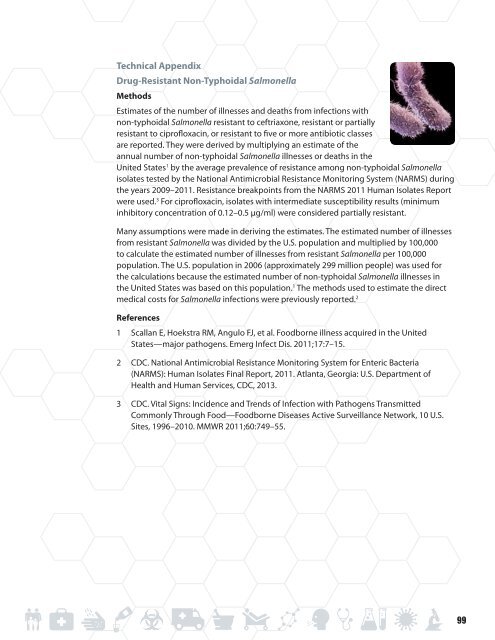Antibiotic Resistance Threats in the United States, 2013 report
Antibiotic Resistance Threats in the United States, 2013 report
Antibiotic Resistance Threats in the United States, 2013 report
Create successful ePaper yourself
Turn your PDF publications into a flip-book with our unique Google optimized e-Paper software.
Technical Appendix<br />
Drug-Resistant Non-Typhoidal Salmonella<br />
Methods<br />
Estimates of <strong>the</strong> number of illnesses and deaths from <strong>in</strong>fections with<br />
non-typhoidal Salmonella resistant to ceftriaxone, resistant or partially<br />
resistant to ciprofloxac<strong>in</strong>, or resistant to five or more antibiotic classes<br />
are <strong>report</strong>ed. They were derived by multiply<strong>in</strong>g an estimate of <strong>the</strong><br />
annual number of non-typhoidal Salmonella illnesses or deaths <strong>in</strong> <strong>the</strong><br />
<strong>United</strong> <strong>States</strong> 1 by <strong>the</strong> average prevalence of resistance among non-typhoidal Salmonella<br />
isolates tested by <strong>the</strong> National Antimicrobial <strong>Resistance</strong> Monitor<strong>in</strong>g System (NARMS) dur<strong>in</strong>g<br />
<strong>the</strong> years 2009–2011. <strong>Resistance</strong> breakpo<strong>in</strong>ts from <strong>the</strong> NARMS 2011 Human Isolates Report<br />
were used. 3 For ciprofloxac<strong>in</strong>, isolates with <strong>in</strong>termediate susceptibility results (m<strong>in</strong>imum<br />
<strong>in</strong>hibitory concentration of 0.12–0.5 µg/ml) were considered partially resistant.<br />
Many assumptions were made <strong>in</strong> deriv<strong>in</strong>g <strong>the</strong> estimates. The estimated number of illnesses<br />
from resistant Salmonella was divided by <strong>the</strong> U.S. population and multiplied by 100,000<br />
to calculate <strong>the</strong> estimated number of illnesses from resistant Salmonella per 100,000<br />
population. The U.S. population <strong>in</strong> 2006 (approximately 299 million people) was used for<br />
<strong>the</strong> calculations because <strong>the</strong> estimated number of non-typhoidal Salmonella illnesses <strong>in</strong><br />
<strong>the</strong> <strong>United</strong> <strong>States</strong> was based on this population. 1 The methods used to estimate <strong>the</strong> direct<br />
medical costs for Salmonella <strong>in</strong>fections were previously <strong>report</strong>ed. 2<br />
References<br />
1 Scallan E, Hoekstra RM, Angulo FJ, et al. Foodborne illness acquired <strong>in</strong> <strong>the</strong> <strong>United</strong><br />
<strong>States</strong>—major pathogens. Emerg Infect Dis. 2011;17:7–15.<br />
2 CDC. National Antimicrobial <strong>Resistance</strong> Monitor<strong>in</strong>g System for Enteric Bacteria<br />
(NARMS): Human Isolates F<strong>in</strong>al Report, 2011. Atlanta, Georgia: U.S. Department of<br />
Health and Human Services, CDC, <strong>2013</strong>.<br />
3 CDC. Vital Signs: Incidence and Trends of Infection with Pathogens Transmitted<br />
Commonly Through Food—Foodborne Diseases Active Surveillance Network, 10 U.S.<br />
Sites, 1996–2010. MMWR 2011;60:749–55.<br />
99
















